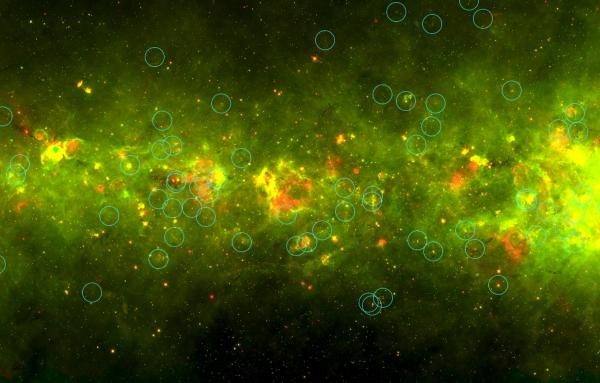Citizen Scientists Discover a new Feature in Star Formation: “Yellowballs”
By Andy Tomaswick
AI is often touted as being particularly good at finding patterns amongst reams of data. But humans also are extremely good at pattern recognition, especially when it comes to visual images. Citizen science efforts around the globe leverage this fact, and recent results released from the Milky Way Project on Zooinverse show how effective it can be. The project’s volunteer team identified 6,176 “yellowballs”, which are a stage that star clusters go through during their early years. That discovery helps scientists better understand the formation of these clusters and how they eventually grow into individualized stars.
This isn’t the first time these features have been studied. The search actually started in 2011, with a relatively innocuous message on a message board for the Milky Way Project : “Any ideas what these bright yellow fuzzy objects are?” With that began the collective search for these newly found yellow smudges that eventually became known as yellowballs. Over the last few years, a catalogue of these objects has been growing, with the occasional peer reviewed paper presenting the results form the citizen science efforts.
Credit: ScienceAtNASA YouTube Channel
That effort has resulted in a much better understanding of what these unique astronomical features actually are. Yellowballs themselves aren’t actually yellow, at least not what we would normally perceive as yellow. They are yellow only in infrared images collected by the Spitzer Space Telescope and were analyzed as part of the project. What the color yellow represents in the infrared images are dust and trace organic compounds absorbing some of the infrared light.
It appears that young stars produce that yellowing effect by heating the gas and dust they are surrounded by in their early stages. Yellowballs seem to form in the first 100,000 years of a star’s life. Interestingly, it doesn’t appear to matter what size of star is eventually created in the cluster. Around 20% of the yellowballs catalogued resulted in “massive” stars with about 10 times the massive of the sun.

Credit: Charles Keaton, Iowa State University / NASA / Spitzer
Yellowballs themselves are pretty massive though. They start at around a light year across, but expand up to 10 light years across over the course of millions of years when surrounding larger stars. When they get to this stage, they are more commonly known as “bubbles”, and are no longer so yellow, expanding out to a wavelength that looks more red when seen with Spitzer’s infrared collector.
No matter what color they are, these yellowballs are a new chain in the link between early star forming regions and the stars they eventually result in. Further study will allow scientists to link the characteristics of these dense clouds to what kind of stars they eventually result in, solidifying the link between a star’s birth and its eventual composition. Sounds like more work for both citizen and professional scientists.
Learn More:
PSI – “Yellowballs” Offer New Insights Into Star Formation
Futurism – Citizen Scientists Lead Astronomers to Source of Yellowballs
EOS – The “Yellowball” Catalog and the Citizen Science That Helped Define It
Lead Image:
Example of a yellowball (left) and a bubble (right)
Credit: NASA / JPL-Caltech
The post Citizen Scientists Discover a new Feature in Star Formation: “Yellowballs” appeared first on Universe Today.

April 17, 2021 at 04:26AM
via Universe Today read more...

Post a Comment